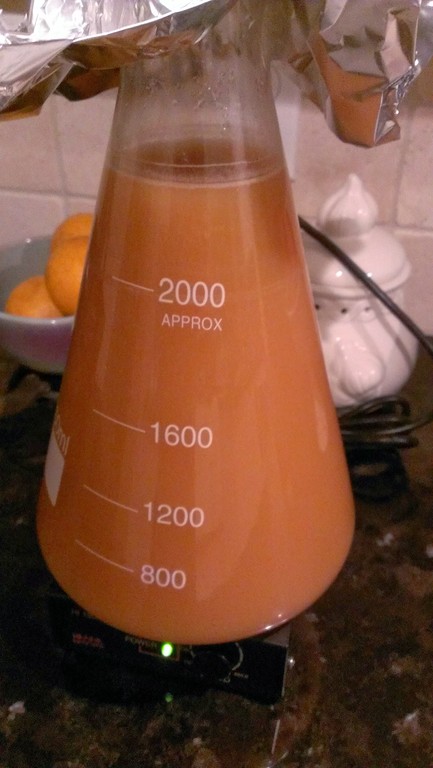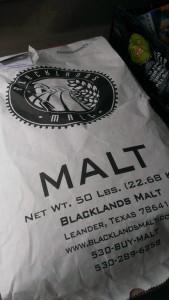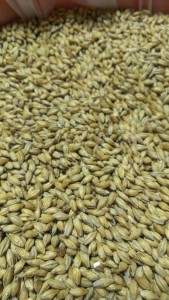
2 liter starter of Wyeast 3724 Dupont Saison yeast. Even on a stirplate, it is a slow fermenter.
Brew plans come and go. By this time I was supposed to already have brewed up 11 gallons of my favorite Russian Imperial Stout so I could fill up a new barrel that had previously held rum. Unfortunate issues surrounding a local bulkbuy have delayed the scheduled brewday. So last brew session I did a Big Barleywine, destined for the 5 gallon whiskey barrel. The shipment is going to be late by only one day; but since I brew on Friday nights, well, it’s time for something else.
I’m on my 4th revision of my house saison. Even from version 1, it’s been a huge hit. Amazingly tasty, just enough spice and light funk, reasonably hoppy, bright citrus. We’ve played with adding Orange Blossom honey, adding in some rye. And of course switching yeasts. The original recipe used Wyeast 3711 Saison, a beast of a yeast and then I switched to 3724. That learning experience is one of the most visited pages on this blog. What I have left to do is actually blend the two together.
I much prefer the flavor profile of 3724; it just has more depth and character than just 3711. But if you’ve read my post or just about anywhere else, the Dupont yeast can be fickle without a lot of patience, aeration and heat. This time however, the plan is to pitch a big starter of 3724 and let that work on the beer for approximately 7 days, or till whenever it stalls. At that point, I’ll pitch 3711 to clean up and finish. This should shorten the fermentation cycle quite a bit but by using 3724 first, the bulk of the flavors will come from the Dupont strain.
I’ve read else where this is a common tactic. In some cases brewers will blend up front, say, 3 to 1, Dupont (3724) to Theriez (3711) in the initial pitch. That may also work, but I don’t want to skip a starter. I’d be worried that the ratios in the starter if blended wouldn’t match up.

Blacklands Malt — Local Craft Malthouse in Leander, TX
In addition to blending the yeast I’ll also be using a new pilsner. Locally malted up at Blacklands Malt, I’m using their White Horn pilsner. I enjoy using local ingredients. The 2-row Pale Moon has been a great grain to work with and I have high hopes for the pilsner as well. After all of the trouble with the bulk buy; if I didn’t also need sacks of Marris Otter, I’d get all of my base grains from Blacklands exclusively.

White Horn Pilsner from Blacklands Malt
This batch of Rekkae has been scaled up to 12 gallons. I plan to use six of the 12 to blend with a few sour saisons that I’m aging. My Farmhouse Saison experiement didn’t end up souring at all. I’m almost 100% sure that was because I had too many IBUs when I pitched the lacto. Blending with a known sour will certainly let me get just the right flavor profile I’m looking for.
Here’s version 4 of Rekkae.
Recipe Details
| Batch Size |
Boil Time |
IBU |
SRM |
Est. OG |
Est. FG |
ABV |
| 12 gal |
90 min |
36.9 IBUs |
7.0 SRM |
1.060 |
1.012 |
6.3 % |
|
Actuals |
1.054 |
1.01 |
5.8 % |
Style Details
| Name |
Cat. |
OG Range |
FG Range |
IBU |
SRM |
Carb |
ABV |
| Saison |
16 C |
1.048 - 1.065 |
1.002 - 1.012 |
20 - 35 |
5 - 14 |
2.3 - 2.9 |
5 - 7 % |
Fermentables
| Name |
Amount |
% |
| Pilsner (2 Row) Bel |
20.803 lbs |
73.35 |
| White Wheat Malt |
3.258 lbs |
11.49 |
| Rye Malt |
2.132 lbs |
7.52 |
| Oats, Flaked |
1.128 lbs |
3.98 |
| Caramunich Malt |
1.042 lbs |
3.68 |
Hops
| Name |
Amount |
Time |
Use |
Form |
Alpha % |
| Fuggles |
0.74 oz |
60 min |
First Wort |
Pellet |
5.3 |
| Sorachi Ace |
0.74 oz |
60 min |
First Wort |
Pellet |
12 |
| Fuggles |
0.74 oz |
30 min |
Boil |
Pellet |
5.3 |
| Fuggles |
1.85 oz |
15 min |
Boil |
Pellet |
5.3 |
Miscs
| Name |
Amount |
Time |
Use |
Type |
| Calcium Chloride |
9.00 g |
60 min |
Mash |
Water Agent |
| Gypsum (Calcium Sulfate) |
9.00 g |
60 min |
Mash |
Water Agent |
| Epsom Salt (MgSO4) |
1.20 g |
60 min |
Mash |
Water Agent |
| Ground Pepper |
3.27 tsp |
5 min |
Boil |
Spice |
Yeast
| Name |
Lab |
Attenuation |
Temperature |
| Belgian Saison (3724) |
Wyeast Labs |
78% |
70°F - 95°F |
| French Saison (3711) |
Wyeast Labs |
80% |
65°F - 77°F |
Mash
| Step |
Temperature |
Time |
| Protein Rest |
122°F |
30 min |
| Saccharification |
152°F |
45 min |
| Mash Out |
168°F |
10 min |
Notes
| Water profile via Brun Water, says 5.5 target pH. |




